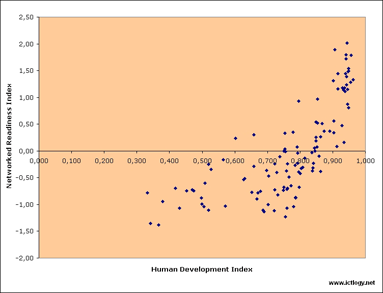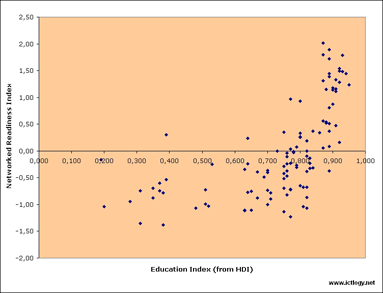By Ismael Peña-López (@ictlogist), 29 March 2006
Main categories: Development, e-Readiness, ICT4D
1 Comment »
The World Economic Forum has released the Global Information Technology Report 2005-2006, being one of the more interesting outputs the Networked Readiness Index (NRI). A pity — like most cases — you have to pay to get the full report.
In open access you can find:
I’d usually finish here my post, but tickling is tickling.
I put in a table both the Networked Readiness Index (NRI) and the
Human Development Index (HDI). In another table, same NRI against the Education Index extracted from the HDI. And plotted a couple of graphics shown below.

[click to enlarge]
On vertical axis, NRI. On horizontal axis, HDI. Main remarks:
- Almost all countries with high NRI are above 0.8 HDI. And they behave in quite a similar way, with a progressive but quick adoption of ICTs the higher the HDI. Significative.
- Notable exceptions: South Africa and India, the last two points on the left, with HDI among 0.6 and 0.7
- Above (around) HDI = 0.6 and up, the tendency stays the same: steppy courve of adoption… but without adoption, as NRI is below 0. Some of them (HDI among 0.6 and 0.7) might be doing the effort of entering ICTs, but to their economies this is a real effort. Some of them (HDI above 0.8) should have their rules fired immediatly and replaced by other ones with better e-awareness (Bosnia and Herzegovina an exception for logical reasons of reconstruction).
- Below HDI = 0.6, those countries with HDI below 0.6 they do have an opportunity to catch up with the potential train-misser ones (the ones with HDI above 0.6 but NRI below 0). Surely the effort would be worth doing it… in case it could be done. These countries are really poor (and most of the poorest don’t even show in the map as they were not counted when computing the NRI!).

[click to enlarge]
On vertical axis, NRI. On horizontal axis, Education Index. I guess same analysis applies than in the previous graphic, though the dispersion is a little bit bigger. It seems as if education was not as important as power in adopting ICTs, as the whole cloud of points looks shifted leftwards some 0.05 in the index (but this could be explained as the HDI itself is 0.05 shifted upwards in relation to the Education Index).
All in all
- Two tendencies: one in the road to ICTs adoption, one just left behind.
- Two groups of countries under NRI under 0: one trying to, the other one completely abandoned to his luck.
- One group of countries (high HDI, low NRI) that could have changed their status in the world scenario if they don’t success / try to catch the digital train.
Sincere thanks to my colleague Albert Padró-Solanet for valuable hints with stats.
By Ismael Peña-López (@ictlogist), 23 March 2006
Main categories: ICT4D
No Comments »
Directed by Phil Howard, the World Information Access Project have released the World Information Access 2006 Report.
It’s a pity the information on their site and booklet is still so scarce, as the report looks really worthy. Some key findings:
Finding 1: Key computing and communication technologies are more concentrated in a few countries, not less concentrated.
Finding 2: Civil society around the world has embraced the Internet.
Finding 3: The design and manufacture of information technology still occurs in a small core group of countries.
Finding 4: People in developing countries – especially countries in Latin America – are putting more cultural content online than they are pouring into books.
Finding 5: Internet access in the world’s mega cities is still a luxury for most residents.
Links:
[Via the ICT for Development Observatory]
By Ismael Peña-López (@ictlogist), 22 March 2006
Main categories: Education & e-Learning, ICT4D, Knowledge Management, Online Volunteering, Open Access, Writings
No Comments »
So, the online magazine UPDATE – Dianova International e-magazine has just published and article of mine entitled e-Learning para el desarrollo [e-Learning for Development].
The article is sort of a remake in Spanish of the Introduction to my paper e-Learning for Development: a model. Thus, there is really nothing new there, but if you can’t read English comfortably, well, you can use it as a good translation.
By Ismael Peña-López (@ictlogist), 21 March 2006
Main categories: FLOSS, Hardware, Knowledge Management, Meetings, Open Access, Writings
No Comments »
Update: For an improved version of the seminar, please
read this.
Update: Added English version of the presentation. Download it
here. Thanks
Peter for
linking: this version goes to you :)
On March 10th I imparted a seminar entitled Web 2.0 and diffusion of research here in Barcelona, at the headquarters of the University.
Please find here the presentation (in Catalan). Hope I’ll find time and translate it into English (done) and/or Spanish.
Abstract:
Buzzword or not, the Internet is changing and the so-called Web 2.0 applications might mean new ways to work in the research-education-diffusion field (i.e. the University field). This presentation’s goal is raising a reflection and showing a “good” practice in difusion of research, after Ismael Peña’s experience in the area of Public policies for development and ICT4D at the Open University of Catalonia and the use of blogs, wikis and other tools in his ICT4D personal portal.
By Ismael Peña-López (@ictlogist), 15 March 2006
Main categories: Hardware, ICT4D
No Comments »
It is now Paolo Massa who writes to me and lets me know about Universitá Degli Studi di Trento‘s doctorate course on Information and Communication Technologies for Sustainable Development.
Lectured by Valentín Villarroel, it has a strong hardware focus, putting the accent in the technologycal part of ICT’s. No doubt, a very interesting program: it happens that I know Valentín personally, have made a short participation in EHAS and know something more than a little about BorgouNET.
My kudos for the organization! :)
By Ismael Peña-López (@ictlogist), 14 March 2006
Main categories: Education & e-Learning, ICT4D
No Comments »
ICT4D Courses page updated courtesy of David Crespo, now following his PhD with Tim Unwin.
 Networked Readiness Index rankings (23 Kb) you can edit and tickle with.
Networked Readiness Index rankings (23 Kb) you can edit and tickle with.


 2006 Briefing Booklet
2006 Briefing Booklet